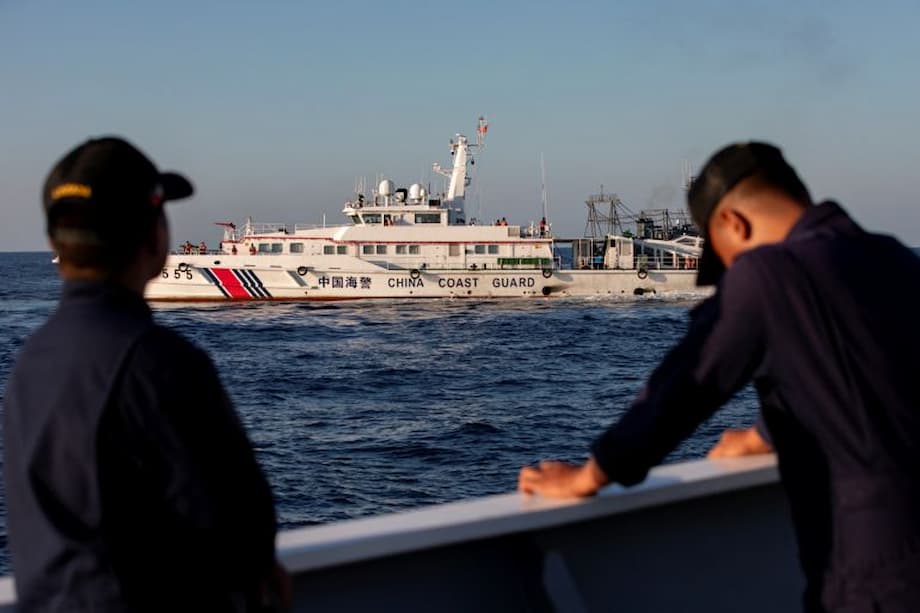Philippines at the Center of Asia’s New Flashpoint
In August 2025, a diplomatic storm erupted across Asia after Philippine President Ferdinand Marcos Jr. publicly stated that his country would inevitably be drawn into any conflict between China and the United States over Taiwan. Marcos’s remarks, made during a high-profile state visit to India and broadcast in an exclusive interview with Firstpost, triggered a sharp rebuke from Beijing, gratitude from Taipei, and a wave of international commentary. The episode has thrown the Philippines into the heart of the Indo-Pacific’s most volatile security dilemma, highlighting the country’s precarious position between two superpowers and the growing risk of regional escalation.
- Philippines at the Center of Asia’s New Flashpoint
- What Sparked the Diplomatic Row?
- Philippines Reaffirms Its One China Policy
- Why Is the Philippines So Exposed?
- Rising Tensions in the South China Sea
- Strategic Partnerships: India, Japan, and the United States
- China’s Broader Strategy: Linking Taiwan and the South China Sea
- Philippine Military Preparations and the Humanitarian Dimension
- The Regional and Global Stakes
- How Is the Philippines Navigating the Diplomatic Tightrope?
- In Summary
President Marcos’s comments were blunt: “If there is an all-out war, then we will be drawn into it. There are many, many Filipino nationals in Taiwan and that would be immediately a humanitarian problem.” With over 150,000 Filipinos living and working in Taiwan, the humanitarian stakes are high. But the strategic implications are even greater. The Philippines’ northernmost islands lie less than 100 miles from Taiwan, making it impossible for Manila to remain a bystander in any cross-strait conflict.
What Sparked the Diplomatic Row?
Marcos’s interview with Firstpost Managing Editor Palki Sharma was the catalyst. He explained that the Philippines’ proximity to Taiwan and its alliance with the United States would make neutrality impossible in the event of war. He emphasized the need for contingency plans to protect Filipino citizens and to coordinate with international partners. Marcos also stressed that Manila was not seeking conflict but was reacting to the “challenges it is facing.”
China’s response was immediate and forceful. The Ministry of Foreign Affairs in Beijing issued a strongly worded statement, warning Manila not to “play with fire” and urging it to uphold the One China principle. “Geographical proximity and large overseas populations are not excuses for interfering in others’ internal affairs,” the statement read. China accused the Philippines of making “provocative remarks,” undermining both international law and the Association of Southeast Asian Nations (ASEAN) charter, and risking regional peace.
Beijing’s embassy in Manila lodged a formal diplomatic protest, and Chinese officials summoned the Philippine ambassador to express “strong dissatisfaction” with Manila’s recent moves regarding Taiwan and maritime security. China’s foreign ministry reiterated its longstanding position: Taiwan is an integral part of Chinese territory, and any foreign involvement is unacceptable.
Meanwhile, Taiwan welcomed Marcos’s remarks, interpreting them as recognition of the island’s vulnerability and the interconnected security environment of the Indo-Pacific. Taiwanese officials praised the Philippines for standing up for regional stability and for acknowledging the humanitarian risks facing overseas Filipino workers in Taiwan.
Philippines Reaffirms Its One China Policy
Amid the diplomatic uproar, the Philippine government moved quickly to clarify its position. The Department of Foreign Affairs (DFA) reaffirmed Manila’s commitment to the One China policy, as established in the 1975 Philippines-China Joint Communique. The DFA emphasized that while the Philippines adheres to non-interference in China’s internal affairs, it consistently advocates for dialogue, regional stability, and the peaceful settlement of differences.
In a statement, the DFA said:
The Philippines upholds its One China policy and non-interference in the internal affairs of other states. At the same time, we remain committed to the safety and welfare of our nationals abroad and to the peaceful resolution of disputes in accordance with international law.
President Marcos himself reiterated that the Philippines was not preparing for war but was compelled to plan for all contingencies due to its unique geographic and demographic realities. He also highlighted the country’s “ironclad” alliance with the United States and growing defense partnerships with other regional powers, including India and Japan.
Why Is the Philippines So Exposed?
The Philippines’ vulnerability in a Taiwan conflict is rooted in geography and demographics. The Batanes island chain, the country’s northernmost territory, is less than 100 miles from Taiwan. The Luzon Strait, which separates the two, is a critical maritime chokepoint for both commercial shipping and military operations. Any cross-strait conflict would almost certainly spill over into Philippine territory, airspace, and waters.
Moreover, the Philippines is home to one of the world’s largest overseas worker populations, with over 150,000 Filipinos living in Taiwan. In the event of war, Manila would face the daunting task of evacuating its citizens across a contested strait, potentially crossing Chinese military and maritime boundaries. Philippine military planners have already drafted contingency plans for such an evacuation, and these scenarios are now being incorporated into joint U.S.-Philippine military exercises.
General Romeo Brawner, Chief of Staff of the Armed Forces of the Philippines, recently told troops in Northern Luzon to prepare for a Taiwan invasion contingency, emphasizing the inevitability of Manila’s involvement and the need to rescue Filipino citizens. He identified the Northern Luzon Command as the leader in any such operation, particularly in the rescue of overseas Filipino workers from Taiwan.
Rising Tensions in the South China Sea
The diplomatic spat over Taiwan comes against a backdrop of escalating tensions between China and the Philippines in the South China Sea. Both countries have traded accusations of aggressive maneuvers, sovereignty violations, and dangerous encounters at sea. Incidents involving ramming, water cannon blasts, and even clashes with spears and knives have become alarmingly common.
China’s expansive claims in the South China Sea overlap with the Philippines’ exclusive economic zone, particularly around disputed features like the Second Thomas Shoal and Scarborough Shoal. The United States, bound by a mutual defense treaty with Manila, has repeatedly reaffirmed its commitment to defend the Philippines in the event of an armed attack, including against coast guard personnel and public vessels.
In recent months, the Philippines has stepped up its military presence in the region, conducting more frequent patrols and joint exercises with the United States and other allies. The Philippine Coast Guard has also begun cooperating with its Taiwanese counterpart in the Bashi Channel, further raising Beijing’s ire.
Strategic Partnerships: India, Japan, and the United States
President Marcos’s state visit to India was not just about diplomacy—it was also about forging new security partnerships. During the visit, Manila and New Delhi signed agreements to strengthen defense ties, including cooperation between their armies, air forces, and navies. Indian warships have begun joint patrols with the Philippine Navy in the contested South China Sea, a move likely to further anger China.
India and the Philippines have elevated their relationship to a strategic partnership, focusing on maritime collaboration, defense equipment cooperation, and adherence to international law. The two countries conducted their first-ever joint naval exercises near the Scarborough Shoal, a hotspot in the China-Philippines maritime dispute. India is particularly interested in the South China Sea because a significant portion of its trade passes through the region.
Japan is another key player in the evolving regional security architecture. The strategic triangle between Taiwan, the Philippines, and Japan is becoming increasingly important as all three countries face the prospect of being isolated by Chinese control of the Taiwan Strait. Japan’s dependence on shipping routes through the Taiwan Strait and Luzon Strait makes it acutely vulnerable to any conflict in the area. Tokyo has pledged to double its defense spending and is deepening security ties with both Manila and Washington.
The United States remains the Philippines’ principal security ally. Under the Enhanced Defense Cooperation Agreement (EDCA), U.S. forces have access to nine Philippine bases, including several in Luzon near Taiwan. The U.S. has deployed advanced missile systems and conducted joint combat exercises with Philippine forces in the Batanes islands, underscoring the alliance’s focus on Taiwan-related threats.
China’s Broader Strategy: Linking Taiwan and the South China Sea
China’s confrontations with the Philippines in the South China Sea are increasingly linked to its broader campaign against Taiwan. Beijing views the region as a strategic buffer and is determined to prevent any foreign interference in what it considers its “core interests.” Chinese officials have framed their actions in the South China Sea as necessary to deter Philippine security cooperation with the United States and to maintain control over strategic waterways.
China’s military modernization, including the deployment of aircraft carriers and advanced missile systems, is aimed at achieving control of the sea and deterring U.S. intervention. The People’s Liberation Army Navy (PLAN) has conducted carrier-based operations near the Luzon Strait, and Chinese coast guard ships have harassed Philippine vessels conducting research and patrols.
At the same time, China is using diplomatic, economic, and information tools to pressure the Philippines and other regional countries. Beijing has protested every hint of growing closeness between Manila and Taipei, including joint patrols, military exercises, and even congratulatory messages to Taiwan’s leaders. Chinese officials have accused the Philippines of “fudging and hollowing out the One China principle” and warned of severe consequences for any perceived interference.
Philippine Military Preparations and the Humanitarian Dimension
The Philippine military is not taking the threat lightly. Under President Marcos, Manila has shifted its defense posture from internal security to external threats, particularly those emanating from the Taiwan Strait and the South China Sea. The Comprehensive Archipelagic Defense Concept now guides military planning, with a focus on defending the country’s maritime borders and preparing for contingencies involving Taiwan.
Recent military exercises, such as Balikatan 2025, have included coastal defense, airfield operations, and maritime domain awareness drills in Northern Luzon and the Batanes islands. The deployment of sensors, missile systems, and aviation assets across the island chain separating Taiwan from Luzon is seen as a deterrent to Chinese aggression and a signal of Manila’s readiness to respond to any crisis.
But the humanitarian dimension looms large. The prospect of evacuating tens of thousands of Filipino workers from Taiwan in the midst of a conflict is a logistical nightmare. Philippine officials have drafted contingency plans for mass repatriation, and these scenarios are now part of joint U.S.-Philippine military planning. Experts warn that any attempt to evacuate citizens could inadvertently cross Chinese military boundaries, risking escalation.
The Regional and Global Stakes
The fate of Taiwan is not just a matter of U.S.-China rivalry. For the Philippines and Japan, the consequences of a Chinese takeover of Taiwan would be profound. Chinese control of the island would fundamentally alter the regional balance of power, potentially isolating both countries and forcing them to accommodate Chinese dominance regardless of U.S. positions.
The Luzon Strait, which separates Taiwan from the Philippines, is a critical chokepoint for global shipping and military operations. Control of this strait would give China the ability to project power into the Pacific and threaten the sea lanes that are vital to Japan, South Korea, and the Philippines. For Manila, the loss of access to the strait would compromise its trade routes and strategic autonomy.
Beyond the strategic calculations, the issue is also about values. Taiwan’s democracy stands as a challenge to China’s authoritarian model, and its fate will determine whether countries like the Philippines and Japan remain sovereign actors in an open regional order or become subordinated to Chinese hegemony.
How Is the Philippines Navigating the Diplomatic Tightrope?
President Marcos’s remarks and the subsequent diplomatic fallout have amplified Manila’s visibility on the global stage. The Philippines is now at the center of a complex web of alliances, rivalries, and security dilemmas. While reaffirming its One China policy, Manila is quietly but significantly building defensive capabilities and strengthening security partnerships with the United States, India, and Japan.
Philippine Defense Secretary Gilberto Teodoro summed up the dilemma: “It would be hiding from the obvious to say that Taiwan’s security will not affect us.” The Philippines is determined to protect its sovereignty, defend its citizens, and maintain regional stability, even as it navigates the competing demands of Beijing and Washington.
As the Indo-Pacific remains a flashpoint of geopolitical competition, the Philippines’ evolving strategic posture reflects the new realities of Asian security. The country’s leaders know that neutrality is no longer an option—and that the choices they make now will shape the region’s future for decades to come.
In Summary
- President Ferdinand Marcos Jr.’s remarks about inevitable Philippine involvement in a Taiwan conflict triggered a sharp warning from China and international debate.
- China accused the Philippines of “playing with fire” and interfering in its internal affairs, while Taiwan welcomed Manila’s recognition of the regional security risks.
- The Philippines reaffirmed its One China policy but emphasized the need to protect its citizens and prepare for all contingencies.
- Rising tensions in the South China Sea and the Luzon Strait have made the Philippines a frontline state in the Indo-Pacific’s security dilemma.
- Manila is strengthening security partnerships with the United States, India, and Japan, conducting joint exercises and upgrading military capabilities.
- China’s confrontations with the Philippines are part of a broader strategy to deter foreign involvement in Taiwan and assert control over strategic waterways.
- The humanitarian challenge of evacuating Filipino workers from Taiwan in a crisis is a major concern for Manila.
- The fate of Taiwan will have profound strategic consequences for the Philippines, Japan, and the entire region, shaping the balance of power and the future of democracy in Asia.












